My mother’s grandfather was one of those domineering patriarchs who governed everything his family did, including the films they saw. The films deemed worthy of watching were very limited; Hollywood, by virtue of producing films with a Biblical theme, managed to get some (like Quo Vadis, The Ten Commandments and Ben Hur) past his strict censorship, but Hindi cinema didn’t have a chance. Kismet holds the distinction of being the only Hindi film he allowed his family to see. Considering it’s quite a formulaic potboiler (with an anti-hero and a girl who gets pregnant without being married), I was surprised at his choice—but then, it may have had something to do with the fact that Kismet was a huge hit that ran for 3 years in a theatre in Calcutta, where my mum’s family lived. Great-granddad must’ve thought anything that sustained so must have some merit.
The story begins in a jail, where long-time thief Shekhar (Ashok Kumar) is being released after completing 2 years: this has been his third stint in prison. Though the jailor exhorts him to be law-abiding, Shekhar’s first task on emerging is to pick the pocket of a thief whom he sees stealing a gold watch from an old man. I think Shekhar will be a goodie and return the watch to the old man; but no, he takes it to a fence (David) and sells it.
While he’s with the fence, the original thief, Baanke (?) turns up, and is pretty put out at finding that Shekhar had whacked the watch from him.
They make up soon enough, and Baanke invites Shekhar to join him in the near future in busting a wealthy man’s safe. He doesn’t say where, but assures Shekhar that he’s working at getting access to the safe.
On his way out, Shekhar bumps into the old man from whom Baanke had stolen the watch. The old man’s very distressed. It turns out the watch was the last possible thing he could sell to keep body and soul together (that was why he’d gone to the fence). Now, he doesn’t even have the money to go and watch Rani at the theatre.
Shekhar’s amused that his old fogy, hardly able to afford a square meal, is still a theatre buff. He therefore decides to treat him to the theatre, and the two of them go off to the Indramahal Theatre, owned by Indrajit Babu (?). While they’re waiting for the show to start, the old man points out Indrajit Babu and his wife (?) in a box opposite. He tells Shekhar that he, the old man, was once the owner of this theatre and Indrajit was his employee. But drink, that curse of the masses, took hold of him and reduced him to serious, crushing penury. He is now heavily in debt to Indrajit, who has taken over the theatre in part payment.
The show—consisting of the song Aaj Himalaya ki choti se—begins, with Rani (Mumtaz Shanti) leaning on a crutch and singing amidst a horde of very active extras who dance and stride and prance about. The old man nearly starts crying when he sees Rani, and out comes another sob story. When Rani was a little girl and a very accomplished dancer, her father—now this wretched old man—had, in a drunken fit, gone on playing the tabla long after Rani had tired. She had fallen and suffered a paralytic attack that ruined one leg. Since then, she’s been crippled. (The flashback scene has some very good dancing by the very accomplished Baby Kamala).
The show over, the old man sneaks away (he’s long disappeared from Rani’s life), but not before Rani sees him with Shekhar. She tries to stop her father, but he leaves, and Rani, limping after him, is nearly hit by a car but Shekhar saves her. There’s immediate chemistry here—Rani is anyway biased in favour of Shekhar since she thinks he is her father’s friend.
In the crowd emerging from the theatre are Indrajit Babu and his wife, who’s wearing a distinctive and expensive pearl necklace. Shekhar takes advantage of the crowd and steals it, then hides it in a violin case he finds lying in a tonga waiting for passengers.
When the police arrive and find Shekhar loitering about, they suspect him (remember that criminal record?). But a search reveals nothing, so they let him go. The tonga, meanwhile, has gone. Shekhar gets another tonga and follows, to find himself ending up at the house where Rani lives with her younger sister Leela (Chandraprabha) and their guru.
Much transpires: Shekhar breaks in and retrieves the necklace; the police see him and give chase; he falls down a rickety staircase in the house; Rani discovers him; the police demand entry and accuse Shekhar of being a thief—but Rani protects him, saying that she knows Shekhar well enough and that he’s a good man.
Shekhar is suitably grateful, and since it’s a rainy night and he’s very wet, agrees to stay the night at their house. The next morning, he discovers just how deplorable the two girls’ plight is. Though their father has decamped, Indrajit Babu holds Rani and Leela liable to pay his debts; every now and then, therefore, Indrajit Babu’s manager turns up, trying to bully Rani into paying back the money. Rani is now in such dire straits that her only recourse is to sell off their piano—but she won’t do even that, because it’s the one thing that reminds her of her father.
When the manager’s taken himself off, Rani confides in Shekhar and it emerges that the girls used to take in tenants, but haven’t been able to get anyone in ages. Shekhar sees this as a good opportunity to help out with their finances and remain in close proximity to Rani. So he becomes a tenant, and a romance soon blossoms, with them sweetly singing Aare baadal dheere to each other.
When Rani shows him an old photograph of her wearing a pearl necklace (which she, to make ends meet, had to sell), Shekhar realises it’s the same necklace he’d stolen from Indrajit Babu’s wife. He gets it back from the fence and gifts it to Rani. All is sweetness and love.
Unknown to Rani and Shekhar, there’s another, though not quite so innocent, romance blossoming in the neighbourhood. Indrajit Babu lives next door, and his son Mohan (Kanu Roy) has loved Leela well but not wisely. She’s been urging him to marry her, but Mohan’s too scared of his formidable father to speak up and say he wants to marry Leela. One day, Leela ends up confessing all: she’s pregnant, and if Mohan doesn’t marry her soon, her name will be mud.
And there’s one last bit of complication in all of this: a long-lost son. The inspector who’s investigating the theft of Indrajit Babu’s wife’s necklace one day comes to their home, and by accident stumbles upon an old and painful episode in the family’s life. 20 years ago, Indrajit Babu’s elder son Madan (his name had, helpfully, been tattooed on his forearm) had run away from home after an altercation with his father. Indrajit Babu’s wife, though Madan and Mohan’s stepmother, loves both boys as her own and has never left off pining for the lost Madan.
And so, we have it all: a thief who shows little sign of reforming, a lost son, an illicit relationship, imminent scandal, looming bankruptcy, a lost father, and a girl with a bad leg. How much more distressing can this get?
It isn’t, actually: somehow Kismet, despite its plethora of seemingly hopeless cases, doesn’t descend into morbidity. It may have meant to be very pathetic, but it’s redeemed by its tuneful songs, by Ashok Kumar’s debonair and charismatic style, and by the unintentional comic relief provided by the very theatrical acting of some characters. A fairly dated film, not bad but not great either.
What I liked about this film:
Ashok Kumar. Where Mumtaz Shanti is theatrical, Ashok Kumar is charming—and his acting is effortless and believable.
Aaj Himalaya ki choti se. I have never been much of a fan of Pradeep, but his forte is definitely patriotic songs. This one, with excellent music by Anil Biswas, is one of the best: a marching song with an infectiously patriotic fervour to it. The smart thing about it is the way it cocks a snook at the British. Kismet was made in 1943 when the British were still very much in India, so Pradeep couldn’t risk putting in words that were obviously anti-British. He got around the censors by putting in one line against the Germans and Japanese, thus giving the song a superficial anti-Axis tone. But the entire flavour of the song (which was also how audiences interpreted it) is definitely anti-British.
What I didn’t like:
The unnecessarily convoluted plot. Fewer elements and fewer complications, and this film would’ve been a whole lot better.
The theatrical acting of some of the cast. While Ashok Kumar, David…
and the actor who plays the inspector (?)…
… are fairly natural, Mumtaz Shanti and the actor who plays Baanke got on my nerves with their exaggerated diction and histrionics. Thoroughly unconvincing.
But. This is an important landmark in the history of Hindi cinema—the first instance of an anti-hero; a very major hit (it grossed an amount which would supposedly have been the equivalent of over Rs 600 million today); and entertaining enough.



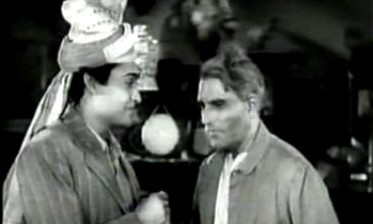
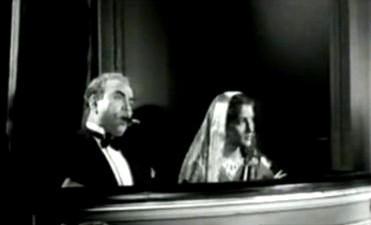
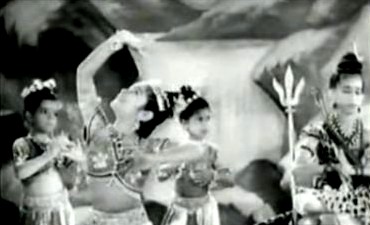


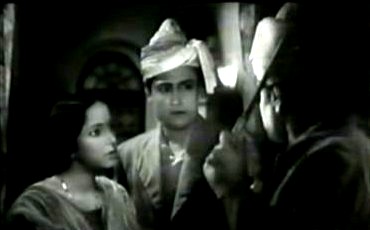
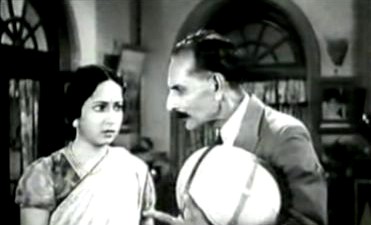
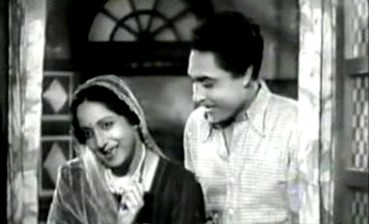


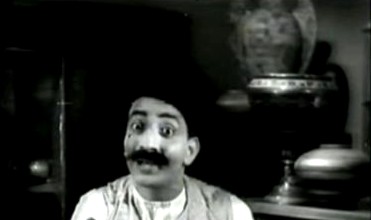

I’ve never liked Ashok Kumar as a romantic…but your post is tempting me to watch Kismet…Great post!!
LikeLike
Yes, I’m also not one of those who find it easy to associate Ashok Kumar with romantic roles. This one’s fairly entertaining, though – and I learnt something I didn’t know before: everywhere in the film, wherever Rani’s posters appear, she’s referred to as ‘Shrimati Rani Devi’. Considering that now shrimati refers only to married women, I thought that was an interesting insight into how languages change – it’s obvious that in the 40’s even a girl could be called shrimati.
LikeLike
Any of this information might be useful:
Ashok Kumar as Shekhar & Madan
Mumtaz Shanti as Rani
Shah Nawaz as Inspector Saahab
V.H.Desai as Baanke
Moti as dancer
P.F.Pithawala as Rani’s father
Chandraprabha as Leela, Rani’s sister
Kanu Roy as Mohan, Leela’s lover
Prahlad
Jagannath Aurora
David as the fence/ Pawn-shop owner
Haroon as Indrajeet’s Manager
Baby Kamala as young Rani
Mubarak as Indrajeet Babu
LikeLike
The first paragraph and I realized that Boyfriend is a ditto copy of this movie (with a few alterations of course)! And the only two differences being –
Madhubala falls down in Shimla on a skating spree and breaks her leg. And Dharmendra plays the role of Mohan and he’s also the inspector in Boyfriend .
LikeLike
You know, I’ve been trying to get hold of Boyfriend, but haven’t been able to find it anywhere. Not in the shops, not with my DVD rental library, not even on induna (at least not the last time I checked). :-(
But I’m sure Shammi Kapoor is waaaay more convincing as a debonair and dashing thief than Ashok Kumar was!
LikeLike
I remember watching this way back in the DD days, and LOVED it. A recent re-watch left me a bit disappointed mainly because I found Mumtaz Shanti awfully annoying. I’ve only seen her in one other film (Ghar Ki Izzat) and she was equally irritating there, not least because she embodies women with a very well-developed martyr complex (the few 40s films I’ve seen seem to be promoting this as the ideal of womanhood). Plus, the contrast between her theatrical acting and Ashok Kumar’s very natural and restrained acting is just too strong – its like a 40s and a 50s film put together! Ashok Kumar though, was soooooo good – I can totally see why he was a matinee idol back then.
LikeLike
PS: Love your new header! Who is the scary lady? She reminds me of Nadira, and yet, looks different too…
LikeLike
Thank you for warning me off Mumtaz Shanti (not that I needed much encouragement – after seeing her in Kismet, I’m not really inclined to delve into her corpus of work!) I don’t know whether I’m the only one who thinks this way, but I get the creepy feeling that in the 40’s and very early 50’s, the actresses tended to be a lot more theatrical than the actors. For instance, in films like Kismet, Dr Kotnis ki Amar Kahaani, Aan and Anmol Ghadi, the men are by and large more natural in their acting than the women. I wonder why…
Thank you! I’m glad you like the new header – what with Ty Power week over, I decided it was time for a change anyway. And you’re right; that is Nadira, in a still from her first film, Aan.
LikeLike
I saw this movie on DD once. I absolutely love the mera bulbul so raha hai song.
I agree, a passable film. The first masala film ever?
LikeLike
Somehow I missed this when it came on Doordarshan – surprising, since we saw just about every film that was ever shown, there was such a paucity of things to see! I’d forgotten that Mera bulbul so raha hai was in Kismet – the only song I recall vividly as being part of the film is Aaj Himalaya ki choti se: I saw that on Chitrahaar and fell in love with it straightaway!
Yes, it does sound like the earliest masala film, no? Though I wish I could lay my hands on some of those early Fearless Nadia or Ruby Myers films – with names like Hunterwaali and Bambai ki Billi, I think they might easily qualify for that honour.
LikeLike
Oh, I would love to find a copy of this on DVD with English subtitles! (I’m assuming there aren’t any – though anyone can feel free to correct me if I’m wrong… I’d even chance a Friends purchase to get this.) I’ve enjoyed some of the music from this a lot (you know I like ’40s Hindi film music and most music by Anil Biswas), and judging from the clips I’ve seen, Ashok Kumar does seem very good in this. But I’d love, especially, to catch this breakthrough performance by Baby Kamala. She looks quite adorable in the screen cap – a sweet little kid – but I would bet she was already a better bharatanatyam dancer than any adult or teenager you could find in the movies at this time and for at least the next five years.
LikeLike
First of all i’m loving your new header, who’s that fierce woman or is it a man in drag? and what film is that cap of him/her from?
I’ve long been intrigued by this film, as various sources have listed Ashok’s role as the first anti hero in the history of hindi cinema so its nice that you’ve written it up, clears up some of the mysteries around it. The aaj himalaya song reminds me a lot of the chamka ban ker aman song from Ek hi raasta
LikeLike
Richard: Unfortunately, I don’t think there’s a DVD available – I watched a VCD (and by Friends, moreover!) And the songs are lovely, of course… when I was a kid in the 80’s, these used to be played pretty frequently on the national TV channel, Doordarshan. Baby Kamala is excellent; I just wish there had been more of her dancing. The clip that’s shown is only about a couple of minutes (or do we have Friends to thank for some brutal editing? I fear not, in this case).
bollywoodeewana: Yes, I hadn’t realised it, but Aaj Himalaya ki choti se sounds and looks a good bit like Chamka bankar aman ka taara, doesn’t it? Thank you for that!
The fierce lady (No! Not a man in drag! God forbid) is Nadira, in a still from her first film, Aan. It’s such an arresting still, I just had to use it in my new header! :-)
LikeLike
I love this movie! Not only does Ashok Kumar turn in a cool and confident performance as the cynical, urbane thief but the tone of the movie itself is so modern that I had to remind myself that it was made in 1943. I also didn’t have the issues you and Bollyviewer had with Mumtaz Shanti and found her portryal of the destitute but resourceful and gentle Rani quite convincing.
LikeLike
We’ll have to agree to disagree on Mumtaz Shanti, then! But Ashok Kumar is I think the highlight of this film: he is such a natural. Excellent!
LikeLike
I think I saw Kismet on DD years back, but can’t remember anything about it now. But a film with Ashok Kumar can’t be bad. I luv Ashok Kumar in romantic leads as well and I can imaigne he is good as a dashing debonair crook!
What does your mom say about Kismet?
My Mom is a big fan of Ashok Kumar, though in the presence of Dad she always denies it.
Mumtaz Shanti! I am sure I saw another movie with her as well. But don’t think she impressed me with her histrionics!
LikeLike
Great Header!
Photo shop?
LikeLike
Mummy was too small to have been taken to see the film (she was born in 1942, so even if the family saw the film towards the end of its 3-year run, she must’ve been only about 5 at the time). At any rate, she doesn’t know anything about it – except that it had acquired a sort of legendary status with my grandmother and her bhabhi as the only Hindi film they saw while their father-in-law was alive. Later, especially in the 70’s, my grandmother used to go off and see all the latest Hindi films with her two bahus, and used to often give us recommendations too!
Thanks re: the header. Yes, Photoshop zindabad!
LikeLike
I have this but haven’t watched it yet since … no subtitles :( But now that I know the basic story (and it does sound like Boyfriend) maybe I can tackle it. I find Ashok Kumar VERY convincing as a hero ;-)
LikeLike
And if you find anything in the latter half that’s confusing, do holler! Pretty straightforward, though, I think…
LikeLike
Have never seen it, but have heard tons of course, but Ashok Kumar is always good. The plot does sound very convulated.
I wonder why more fellow actors at the time didn’t try to follow Ashok Kumar’s more natural style as he was so successful doing it.
LikeLike
Yes, Ashok Kumar, even in the early days, was never affected or theatrical. Perhaps it wasn’t fashionable to act that way? That’s the only reason I can imagine for others not doing it!
LikeLike
The actor who plays Baanke is a young V. H. Desai (I think going from the screencap). He’s hilarious in ‘Andaz’ — not so here? I love him though just for the crazy Professor DDT stuff. :)
Rani’s Father is P. F. Pithawala. The Manager is Haroon.
LikeLike
Thank you! Didn’t know any of those!
LikeLike
superb. i have seen that movie 2 times. superb film by ashok kumar
LikeLike
Hey, this is a wonderful post. I happened to watch this movie only yesterday and found it so endearing. The background score by Anil Biswas is really good and I loved Dheere dheere aa re… sung by Ashok Kumar and Ameerbai. Do drop in to read my blogs on some classic Indian films and keep writing. I am glad there is some engaging commentary happening on these landmarks of Hindi cinema. It is sad that there is very little on the net on cinema prior to independence.
LikeLike
Thank you! I’m glad you liked the review. You’re right about there being very little on the net on cinema prior to independence, but I’ve reviewed a few films here (including Rattan, Anmol Ghadi, Dr Kotnis ki Amar Kahaani and the excellent Neecha Nagar. If you haven’t yet discovered http://www.memsaabstory.wordpress.com, that’s another blog I’d recommend – Memsaab has reviewed quite a few rare old movies.
BTW, which are your blogs? You haven’t said.
LikeLike
Oh yes… I blog at visionsofcinema.blogspot.com
LikeLike
Thanks! Will have a look.
LikeLike
Since 1960 I was after the song ,” mera bulbul sorahahai” I am mad about this song.no more words from me is possible.
LikeLike
You are doing a good job whoever you are.You may have created this blog casually, but believe me, for someone like me who is researching vintage movies, blogs like yours are immensely helpful.I like the way you have analysed the whole movie in fine detail.Thank you.
LikeLike
No, I didn’t create it casually! :-) I am a writer, and I love old movies, so the logical thing seemed to be to write about old movies. Glad you like this blog!
LikeLike
It was nice to hear from you.I saw your comment in my inbox only today.Keep up the good work.
LikeLike
Mera bulbul sora hahai. ……oh ? what a composition …….it has a great message of love and affections in the purest form…..
LikeLike
Yes, it is very sweet.
LikeLike
:-) Thanks!
LikeLike
read all comments about kismet and it was reaally heartening see so many ashok kumars fans.in hundred years of indian cinema indian film industry has forgotten the great ashok kumar. not even a single mention was made in mumbai film festival. it is really sad.ashok kumar was the first real super star of indian cinema and not rajesh khanna .kismet was first cmmercial film of india. what ashok kumar and kismet gave is still beingrepeated in all indian films. a piece of information read in mantos meena bazar manto says that ashok kumar used to charge rs one lac per film in mid forties.ashoks stature can be measured by reading dev anands autobiography romancing with life and by watcning jewel thief where titles begin dev anand presents ashok kumar in vijay anands jewel thief then main titles follow.
LikeLike
True – he was in a class by himself.
LikeLike
Happy to note “Kismat” got attention which it deserved.
I love another song of Lata…….”Saavari saavari “. It may be much before 1960 hindi film song.
I will be immensely happy if some friend comes out with details.
Lataji and Ravishankar’s songs are live even today.
LikeLike
It might help if you could provide something more than just “Saanwari saanwari” – even a couple of more words of the lyrics would be useful. With just those two words, I can’t figure out which song you mean…
LikeLike
The wording of song is SAAVARI ….SAAVARI ….
Lyrics -Ravishankar
Singer-Latamangeskar.
Year – round about 1960.
Even though the rhythm is beating in my head….. I cannot spell them, because I know hindi little only to enjoy the songs.
Any way thank U 4 taking interest in my hunt.
LikeLike
Could it be this one? Saanwre-saanwre kaahe mose karo jora-jori. It’s from Anuradha. Somehow, I always think of the other songs of this film when I think of Anuradha, but this one is certainly beautiful.
LikeLike
Oh. …. ” eureka “…….. I am immensely happy.
I am ending this to go back to listen my life’s favorite song.
Thank U………Thank U…………excuse me I’m in hurry.
The song must have a very very good meaning also.
The last line steals anybodies heart.
I will come to U again. Bye 4 now
LikeLike
The old songs soothed , they conveyed good meanings , depicted love in most subtle form.
Hats off to composers singers and musicians.
LikeLike
I’m so glad! Enjoy. :-)
LikeLike
Now u have opened the treasure of old songs world.
LikeLike
Hi Madhu, let me fill a few gaps here:
Indrajit Babu = Mubarak (a leading actor in the late silent/ early talkie era)
Inspector saahab = Shah Nawaz (who played Ashok Kumar’s elder brother in Jhoola)
Baanke = V.H. Desai (an extremely popular comedian in the 40s)
Rani’s father= P.F. Pithawala (who played Ashok Kumar’s father in Achhut Kanya)
Indrajit’s manager= Haroon
Incidentally, Shah Nawaz, Mubarak and Mumtaz Shanti (out of the ones I’m aware of) moved to Pakistan after partition.
LikeLike
Thank you!
LikeLike
Most welcome! Sadly, there’s no information available online about most of the characters. But for Manto, I daresay actors like V.H. Desai would have been long forgotten today.
LikeLike
True… as it is, today most people wouldn’t even know who Mumtaz Shanti was, let alone the others.
LikeLike
Forget Mumtaz Shanti, I doubt if too many people from today’s generation (the under 20s) would know even Ashok Kumar. Why, I myself never knew that he had once been a star until 3-4 years ago.
Incidentally, I wrote a series of 3 articles dedicated to Kismet some time ago. You can look it up at http://saboute.blogspot.com
LikeLike
True. I suppose the average teenager today wouldn’t have a clue who Ashok Kumar was. I am lucky in that even though his days as a hero were well behind him by the time I began watching films, but he was still a prominent enough figure on TV and as a character actor in films. Plus, since we only had one channel on Doordarshan back then (and it showed a fair number of old films, including stuff like Duniya na Maane), one sort of ended up, willy-nilly, getting to be better acquainted with the past. Today, with so many TV channels, choosing to watch old cinema is really that – a matter of choice.
Thank you for the link to your blog. I’ll check out your articles!
LikeLike
One small correction: I had earlier mentioned that Mubarak (who played Indrajit) moved to Pakistan after partition, but I’m not so sure now. Jab Pyar Kisise Hota Hai (1961) featured an actor called Mubarak and from the screenshot in your review, it certainly appears to be the same person, in which case we can safely assume that he not only remained in India, but continued acting right into the 60s.
LikeLike
Though it might be that he was one of those (like Dilip Kumar’s brother, Nasir Khan) who went to Pakistan and then came back…
LikeLike
I understand Kismet ran for 3 years in Roxy Cinema, Calcutta (as the city used to be called back then). Given that it was released in Jan 1943, coinciding with the Bengal famine, its surprising that there were people out there who had the luxury of watching movies!
LikeLike
The running for 3 years in Calcutta is probably the reason by great-grandfather decided there must be some merit in the film!
You must remember, though, that despite the famine, Calcutta was a busy place during the war. It was an important city still for the British, so it’s not surprising that life must have been much easier there than in the countryside, where the famine really hit badly.
LikeLike
I shudder to think how it must have been in Bengal at the time. Incidentally, the fact that most of the grain hoarders/ merchants were Hindus (and many of the 3 million odd who starved to death were Muslims) proved significant when Jinnah called for direct action three years later.
LikeLike
Ah. I didn’t know that. Thanks for that information. Interesting – and so very sad.
LikeLike